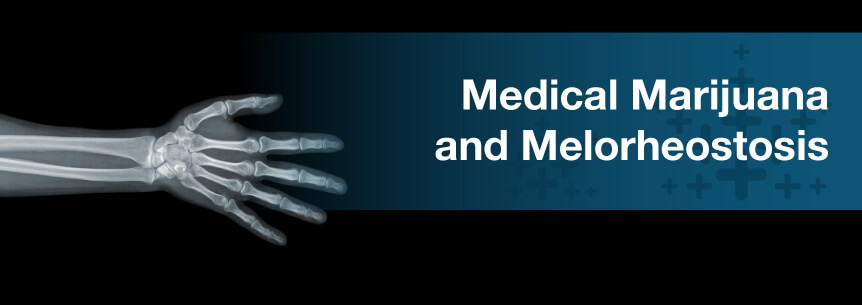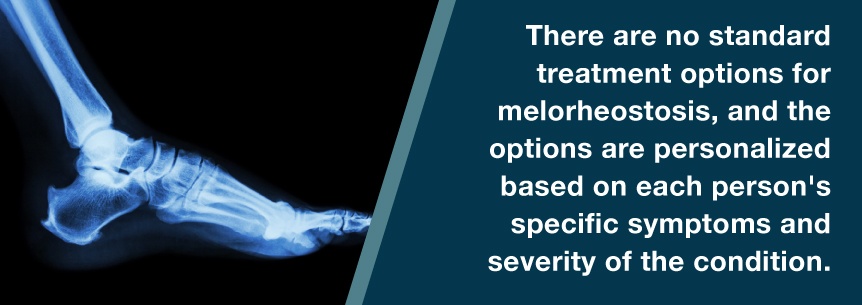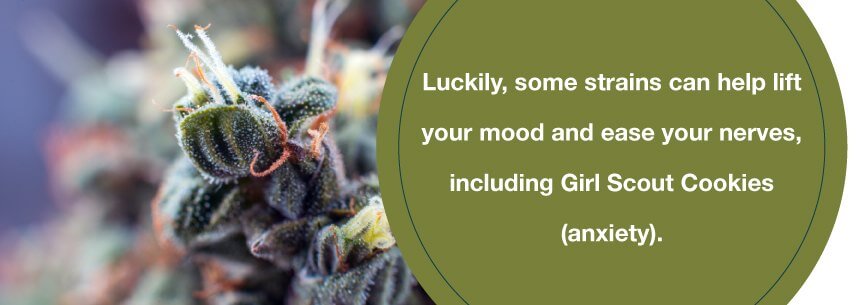
Individuals with melorheostosis can experience severe joint pain, swelling, and stiffness, as well as abnormal muscles and a whole range of movement limitations. As if the physical symptoms aren’t bad enough, they are often dealing with the emotional toll the symptoms take on them, and this can lead to anxiety and depression.
Treatments and medications for melorheostosis symptoms come with their own set of harsh and unpleasant side effects. Medical cannabis can help ease not only some of the symptoms of the condition itself but can also help lessen many of the harsh side effects of the current treatments.
Melorheostosis is a rare bone disease that causes abnormal new bone tissue growth on the existing bones’ surface. On X-rays, the new bone has a distinct appearance often described as “dripping candle wax” or “flowing.” This excess bone growth often occurs on bones of one leg or arm. However, it can also affect other bones including the ribs, pelvis, and sternum.
Melorheostosis’s abnormal bone growth is benign — meaning it’s noncancerous — and doesn’t spread from bone to bone.
Symptoms and signs of melorheostosis include:
While not as common, you can also experience severe bone lesions compressing the surrounding nerves.
The condition typically affects one specific segment of the legs or arms. It’s rarely bilateral and is often limited to one side of the body. It’s also generally within a limb restricted to either the lateral or medial side of the bones.
Your symptoms can get worse over time.
In children, melorheostosis usually presents with deformity, limb length inequality or joint contractures. Symptoms of joint stiffness, progressive deformity and pain are more apparent in adults.
The age of diagnosis varies widely in adults and children and usually is based on the condition’s severity of onset and the symptoms experienced. Physicians may notice melorheostosis in early childhood, sometimes even in the first days of life. About 50 percent of individuals with the condition develop symptoms by the time they turn 20 years old.

The exact cause of the condition is still not known. In a small number of individuals with melorheostosis who have family members with Buschke-Ollendorff syndrome or osteopoikilosis, medical experts identified a LEMD3 gene mutation. LEMD3 gene mutations have been predominantly found in individuals with either of these two conditions.
The LEMD3 gene codes for a nuclear membrane protein which hinders bone formation. But most of the sporadic melorheostosis patients don’t have a LEMD3 mutation. The present theory is a somatic mutation only present in affected tissues causes the melorheostosis.
Melorheostosis isn’t a life-threatening condition, but it can affect your quality of life significantly because of chronic pain that may reappear or become worse, even despite surgery.
Most individuals with the condition suffer from pain, which is often long-lasting and chronic and can range from feeling dull to penetrating and sharp. Skin and tissue hardening around the affected bone can lead to stiffness, and the skin can be red, shiny and swollen with prominent veins.
When the condition involves a joint, it can lead to a joint contracture such as limited joint movement. Melorheostosis can also affect growth — for instance, an affected limb may be shorter than a limb not affected. If the condition coincides with another syndrome or bone disorder, other symptoms and signs might be present.
Other complications may include:
Melorheostosis might present as atypical or mixed osseous involvement along with the classically described “dripping candle wax” hyperostosis appearance. Some individuals might also have Buschke-Ollendorff syndrome, a rare genetic disorder affecting the skin and bones.
Individuals with melorheostosis often also experience depressed mood, fatigue, anxiety and stress.
Many individuals with chronic illnesses become depressed. Depression is among the most common complications reported with chronic illness. About a third of patients with a serious chronic illness have depression symptoms.
Statistics provided by the U.S. National Library of Medicine show:
L’eri and Joanny initially described melorheostosis in 1922. It’s a rare noninherited, congenital disease. It has no known cause. The word melorheostosis comes from the Greek melos, rhein, and osteon, and roughly translates to limb-flow-bone, referring to the dripping wax appearance of bones in X-rays.
It can be a challenge for physicians to make a diagnosis for a rare or genetic disease. Doctors usually look at your symptoms, medical history, laboratory test results, and physical exam to make a diagnosis.
There are no standard treatment options for melorheostosis, and the options are personalized based on each person’s specific symptoms and severity of the condition. The goal of treatment is to correct a deformity, relieve pain and restore movement.

Treatment options might include:
These will help to transform the bone remodeling process.
Managing pain can also be challenging for any condition, including melorheostosis. Pain medications your doctor may prescribe or recommend might include steroids, non-steroidal anti-inflammatory drugs (NSAIDs) or sometimes narcotics. These pain medications are most helpful in the early stages of the disease when it’s in constant progression, but could be less helpful for those who are severely affected. Patients can also become addicted to narcotics ― a troubling side effect on its own.
Side effects of steroids may include:
Side effects of NSAIDs may include:
Side effects of narcotics may include:
Before starting any medication, consult with your doctor about potential side effects. You can know what to expect or look for in advance and decide if it is a side effect you can live with.
Better characterization of developmental and genetic factors, in the future, predisposing people to the condition might lead to targeted therapy, as well as for more common skeletal abnormalities.
Currently, one clinical trial is recruiting patients involving melorheostosis.
As you’ve learned, melorheostosis can cause a variety of symptoms, and medical marijuana can offer relief.
Melorheostosis can lead to substantial pain and stiffness. Chronic pain can often be disabling and can affect every aspect of your life. Chronic pain can make any activity challenging, even something as simple as tying your shoes or buttoning your shirt. Over time, as melorheostosis symptoms take their toll, you may start feeling depressed because you’re constantly struggling with the pain.
When you’re constantly struggling with pain for a long time, it can have a significant detrimental effect on your psychological and emotional health as well. You might feel isolated from your family and friends if you can’t participate in activities you once enjoyed. The physical discomfort might affect your sleep, leaving you feeling exhausted all the time. You might not be able to hold down a job and consequently find you can’t afford your usual standard of living.
If you’re suffering from chronic pain, medical marijuana may alleviate your symptoms significantly and enhance your quality of life. Studies have shown medical weed is an effective method for treating chronic pain and is a lot safer than other treatment options.

Melorheostosis also causes swelling of the joints. Many people realize the anti-inflammatory properties of cannabis, making medical marijuana an excellent treatment alternative for helping with swollen joints.
Medical pot is effective in reducing not only chronic inflammation but also inflammatory-related pain because of its two main cannabinoids — tetrahydrocannabinol (THC) and cannabidiol (CBD). Both of these two cannabinoids help reduce disease-related inflammation.
Another compound that’s recently been shown to affect your CB2 receptor is beta-caryophyllene. In one study, researchers evaluated mice with swollen paws. They gave the mice beta-caryophyllene doses orally resulting in a 70 percent inflammation reduction. The mice without CB2 receptors showed no improvement.
Marijuana also helps ease depression and anxiety symptoms. In a survey, out of the 4,400 individuals surveyed, the people who used the herb showed fewer depression signs than those who didn’t.
Other studies evaluating the effect CBD has on human psychology also showed medical cannabis could act as an anti-anxiety medication. Back in the 1980s, researchers found CBD tended to decrease anxiety symptoms in people.
Cannabis can help treat many melorheostosis symptoms, but it’s especially effective in helping to relieve severe pain, depression, anxiety, inflammation and nausea from other treatments.
Medical marijuana works as:
No matter how you use cannabis as a treatment, there are numerous strains created specifically to tackle your symptoms.
Individuals struggling with pain could benefit from strains that are relaxing and provide painkilling terpenes. Indica strains seem to work well for pain. Some good pain-relieving strains include:
Marijuana strains rich in CBD are suitable for individuals looking for anti-inflammatory, anti-pain and anti-spasm effects. These are all linked with inflammation. Try these inflammation-fighting strains:
Many of the medications prescribed to treat pain related to melorheostosis cause nausea and vomiting. If you have to deal with chronic pain day in and day out, it can lead you to feel nauseated. You can help combat this by trying these nausea-relieving strains:
Chronic illness can take a toll on your emotions and significantly impact your quality of life. The pain alone can make regular activities seem daunting and almost impossible. Chronic illness and pain can also cause an individual to become depressed or anxious. Luckily, some strains can help lift your mood and ease your nerves, including:

Along with choosing the right medical marijuana strain for your individual melorheostosis needs, you also need to consider your consumption method. Each delivery method has its own effects, and there are many options to choose from. Therefore, you should have no problem finding a method that works for you.
Smoking cannabis offers the fastest effect, which is useful when you’re feeling nauseous all of a sudden and need quick relief. But, smoking pot, like with tobacco, can release harmful toxins. If you want to stick with inhaling your treatment, vaping may be your best option.
If you want to avoid inhaling the herb altogether, there are better alternatives such as:
It may take trial and error before you find your preferred option or combination of methods for your medical cannabis dosing.
To get the most out of your medical marijuana treatment plan, it’s imperative you find a qualified cannabis doctor and dispensary. An experienced medical marijuana doctor can provide you with the recommendation you need to get started.
Dispensary staff have the proper knowledge to help point you in the right direction of the cannabis products you can purchase for your melorheostosis specific symptoms.
If you’re struggling with melorheostosis and are considering medical cannabis to treat your symptoms, book your appointment here at MarijuanaDoctors.com and let us help you improve your quality of life. We have many resources available to help you start using medical cannabis for melorheostosis.
Find A Doctor Find A Dispensary